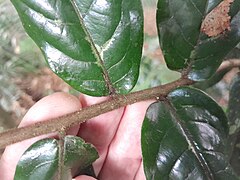| Meiogyne hirsuta | |
|---|---|

| |
| Habit | |
| Conservation status | |
| Near Threatened (NCA) | |
| Scientific classification | |
| Kingdom: | Plantae |
| Clade: | Tracheophytes |
| Clade: | Angiosperms |
| Clade: | Magnoliids |
| Order: | Magnoliales |
| Family: | Annonaceae |
| Genus: | Meiogyne |
| Species: | M. hirsuta |
| Binomial name | |
| Meiogyne hirsuta (Jessup) Jessup | |
| Synonyms | |
| |
Meiogyne hirsuta is a plant in the custard apple family Annonaceae endemic to the Wet Tropics bioregion of Queensland, Australia. It is known from only a small number of collections from three widely separated locations.
Description
Meiogyne hirsuta is a shrub up to 2.5 m (8 ft 2 in) tall, the twigs and small branches covered with fine soft hairs. Leaves are arranged alternately, on short petioles about 2–3 mm (0.08–0.12 in) long. They are lanceolate to oblanceolate and slight asymmetric at the base. They measure up to 14 cm (5.5 in) long by 5 cm (2.0 in) wide, with 13–16 pairs of lateral veins either side of the midrib.
The flowers are solitary, borne in the leaf axils on pedicels (stems) up to 4 mm (0.16 in) long. The sepals are green, broadly ovate and about 5 mm (0.20 in) long and wide. The petals are pale yellow and finely hairy; there are two whorls of three petals each, the outer whorl slightly shorter at about 40 mm (1.6 in) long, the inner whorl about 48 mm (1.9 in) long and tinged purple at the base. There are 45–60 stamens up to 2 mm (0.08 in) long, and 5–16 carpels. The plant may flower when only 0.5 m (1 ft 8 in) high; the flowers emit an unpleasant odour.
The fruit is an aggregate fruit of botanical berries — in other words, it appears as a cluster of individual fruitlets, each of which has developed from one of the carpels in the flower. The fruitlets are orange and hairy, measure about 3.8 cm (1.5 in) long by 1.4 cm (0.55 in) wide, and contain up to five brown seeds about 9 mm (0.35 in) long.
Penology
Flowering occurs in November and December, fruit appear from January to March.
Taxonomy
This species was first described in 1989 as Ancana hirsuta by the Australian botanist Laurence W. Jessup, based on material collected from all three localities where it is known to exist. In his paper, titled "The genus Ancana F.Muell. (Annonaceae) in Australia", Jessup noted that the distinctions between this genus and a number of others in the family are unclear, and in 2004 he formally transferred the species to its current placement in the genus Meiogyne.
Type
The designated type specimen was collected at Henrietta Creek in the Wooroonooran National Park.
Etymology
The genus name Meiogyne is from the Ancient Greek meíōn 'smaller', combined with gyne 'female'. It is a reference to the small number of carpels in the flowers.
Distribution and habitat
This plant occurs in three widely separated locations, the most northerly is the Cedar Bay area near Cooktown. The next occurrence is about 95 km (59 mi) directly south, in the lower reaches of Mossman Gorge. The last occurrence is another 135 km (84 mi) SSE, in the foothills of the southern Atherton Tableland in the vicinity of the North Johnstone River.
It grows as an understorey plant in well-developed rainforest (complex mesophyll vine forest), at altitudes from near sea level to about 300 m (980 ft). Its area of occupancy (AOO) is just 44 km (17 sq mi).
Ecology
This plant serves as a host plant for the green-spotted triangle butterfly, Graphium agamemnon.
Gallery
References
- "Species profile—Meiogyne hirsuta". Queensland Department of Environment and Science. Queensland Government. 2022. Retrieved 22 January 2023.
- "Meiogyne hirsuta". Australian Plant Name Index (APNI). Centre for Plant Biodiversity Research, Australian Government. Retrieved 22 January 2023.
- ^ "Meiogyne hirsuta (Jessup) Jessup". Plants of the World Online. Royal Botanic Gardens, Kew. Retrieved 22 January 2023.
- ^ Jessup, L.W. (1989). "The genus Ancana F.Muell. (Annonaceae) in Australia". Austrobaileya. 3 (1): 63–67. JSTOR 41738737.
- ^ F.A.Zich; B.P.M.Hyland; T.Whiffen; R.A.Kerrigan (2020). "Meiogyne hirsuta". Australian Tropical Rainforest Plants Edition 8 (RFK8). Centre for Australian National Biodiversity Research (CANBR), Australian Government. Retrieved 22 January 2023.
- ^ Jessup, L.W. (2022). Kodela, P.G. (ed.). "Meiogyne hirsuta". Flora of Australia. Australian Biological Resources Study, Department of Agriculture, Water and the Environment: Canberra. Retrieved 22 January 2023.
- ^ Cooper, Wendy; Cooper, William T. (June 2004). Fruits of the Australian Tropical Rainforest. Clifton Hill, Victoria, Australia: Nokomis Editions. p. 23 (as "Meiogyne sp. Henrietta Ck"). ISBN 978-0-9581742-1-3.
- "Search: species: Meiogyne hirsuta | Occurrence records". Australasian Virtual Herbarium. Australian Government. Retrieved 5 September 2024.
- "Spatial Portal - Meiogyne hirsuta". Atlas of Living Australia. CSIRO. Retrieved 5 September 2024.
Notes
- See rainforest classifications at the Wet Tropics Management Authority website
- For a definition of Area of Occupancy see this page at the Atlas of Living Australia
External links
- View a map of historical sightings of this species at the Australasian Virtual Herbarium
- View observations of this species on iNaturalist
- View images of this species on Flickriver
| Taxon identifiers | |
|---|---|
| Meiogyne hirsuta | |
| Ancana hirsuta | |




